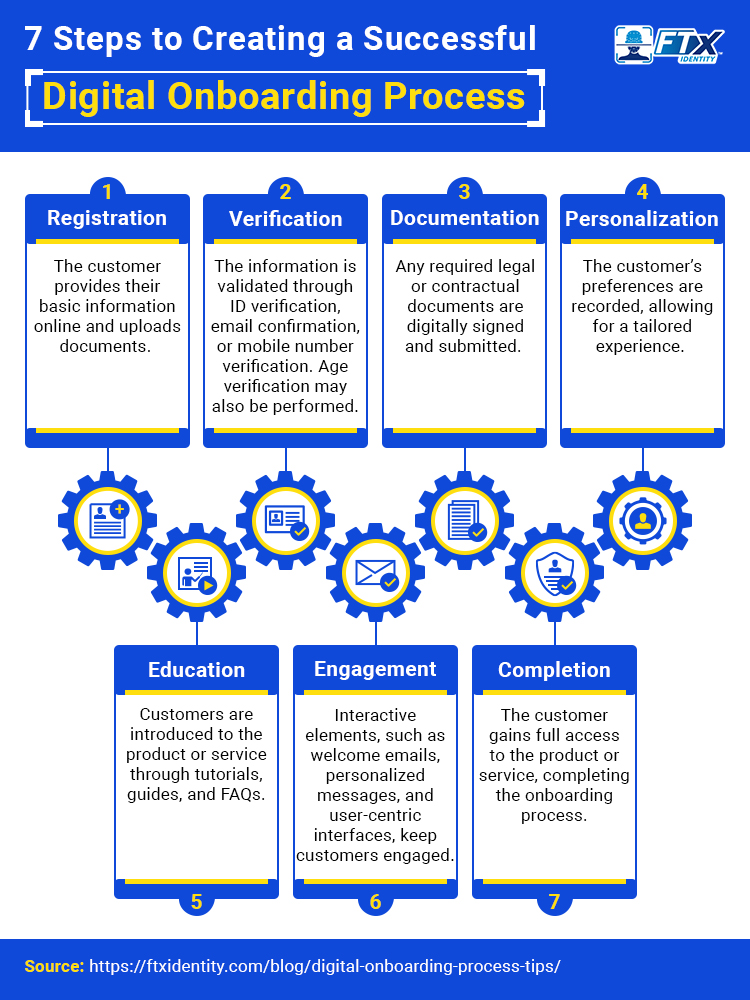A user-friendly digital onboarding process is key to success online.
Whether you’re running an ecommerce shop, or you’re launching a banking app (with specific KYC requirements), the way you enroll customers can make or break progress. A streamlined process, for example, will get people enrolled and engaged faster, while a complicated process may crater app engagement rates.
What goes into a successful digital onboarding experience? We’ve highlighted some key design tips for digital onboarding processes that will ensure a seamless customer journey (along with suggestions for processes that include KYC and identity verification ).

What is Digital Onboarding?
Digital customer onboarding is the process of enrolling a customer online. This could include:
- Signing up for an app
- Registering for a new website
- Making a purchase online
- Authenticating a user in a banking app
The process includes various steps – from the initial customer visit, to using your app or website as a verified user. And special care needs to be made to design a process that’s user-friendly. If you fail at one step, your entire process might not work and your app or website will bleed users.
Digital Onboarding Process: Overview
The onboarding process should be designed to make the user’s journey from registration to full engagement as smooth as possible. A user-friendly process typically includes these steps:
- Registration: The customer provides their basic information online, initiating the onboarding process.
- Verification: The provided information is validated through various means, such as ID verification, email confirmation, or mobile number verification. This may include online age verification for some websites.
- Documentation: Any required legal or contractual documents are digitally signed and submitted.
- Personalization: The customer’s preferences are recorded, allowing for a tailored experience.
- Education: Customers are introduced to the product or service through tutorials, guides, and FAQs.
- Engagement: Interactive elements, such as welcome emails, personalized messages, and user-centric interfaces, keep customers engaged.
- Activation: The customer gains full access to the product or service, completing the onboarding process.
Infographic: 7 Steps to Creating a Successful Digital Onboarding Process

Tip. Understand the most common ways people bypass online verifications to better protect your process.

How to Digitize Onboarding: Advantages and Challenges
Creating an effective onboarding system offers numerous advantages. However, it’s not easy. Here’s a look at some of the key advantages and challenges:
Advantages
1. Enhanced Efficiency
- Digital onboarding streamlines the process, reducing the time it takes to onboard customers.
- Automation of tasks, such as document verification and data entry, minimizes manual effort and human error.
- Faster onboarding means customers can start using products or services sooner, increasing overall satisfaction.
2. Reduced Operational Costs
- Digital processes eliminate the need for physical paperwork, reducing paper and printing costs.
- Fewer manual interventions result in lower labor costs.
- The efficiency gained often leads to cost savings in the long run.
3. Increased Customer Convenience
- Customers can complete the onboarding process from the comfort of their own homes, eliminating the need for in-person visits.
- The ability to onboard digitally at any time suits the busy lifestyles of modern consumers.
- It offers a more convenient and accessible experience, enhancing customer satisfaction.
4. A Wider Reach
- With digital onboarding, businesses can interact with customers no matter where they are, without being limited by distance or location.
- It facilitates global expansion by eliminating the need for a physical presence in new markets.
- The broader reach can result in a larger customer base and increased revenue potential.
Challenges
1. Data Security
- Storing and transmitting sensitive customer information raises concerns about data breaches and cyberattacks.
- Organizations must invest in robust cybersecurity measures to protect customer data and maintain trust.
2. Privacy Concerns
- Digital onboarding involves collecting personal information, which can lead to privacy concerns.
- Complying with data protection regulations, such as GDPR or CCPA, is essential to ensure customer privacy is respected.
3. Varying Digital Literacy Levels
- Not all customers have the same level of digital proficiency, making it crucial to design onboarding processes that are user-friendly for everyone.
- Providing clear instructions, user assistance, and user testing can help bridge the digital literacy gap.
Designing a Seamless Online Onboarding Process
Creating a successful digital onboarding experience requires thoughtful design and strategic implementation.
Here are 7 design tips to ensure your customers have a smooth journey:
- User-Friendly Interfaces: Develop intuitive interfaces that guide customers through each step, minimizing confusion.
- Clear Instructions: Provide concise and easily understandable instructions at every stage.
- Progress Indicators: Display clear progress indicators to keep customers informed about their journey’s status.
- Visual Consistency: Maintain visual consistency in branding and design elements to establish trust and recognition.
- Mobile Optimization: Ensure the onboarding process is seamless across devices, catering to the mobile-first audience.
- Assistance Features: Integrate live chat, chatbots, or help sections to assist customers in real-time.
- Personalized Touches: Tailor the experience based on user data, making customers feel valued and understood.

Digital Customer Onboarding for KYC and Identity Verification: Considerations
Designing a digital customer onboarding process for KYC (Know Your Customer) and identity verification requires special attention. KYC processes are crucial in industries like banking and fintech, where regulatory compliance and security are paramount. Here are some additional steps and considerations:
1. Transparent KYC Procedures
- Clear Explanations: Provide concise, plain-language explanations of the KYC requirements, emphasizing the importance of security and compliance.
- Checklist Guidance: Offer customers a checklist of required documents and information for KYC. This helps them prepare and reduces frustration.
2. Secure Identity Verification
- Biometric Authentication: Implement secure biometric authentication methods such as fingerprint or facial recognition for identity verification.
- Data Encryption: Ensure that all customer data and documents are encrypted both in transit and in storage to protect sensitive information.
- Trust-Building: Communicate your security measures to build trust.
3. User-Controlled Data Sharing
- Data Consent: Allow customers to control what personal information they share during KYC. Provide clear options for consent and data management.
- Transparency: Clearly articulate how customer data will be used, stored, and protected, reassuring customers about their privacy.
4. Efficient Review Process
- Streamlined Review: Design an efficient KYC review process to minimize delays and wait times for customers.
- Automation: Implement automation and data validation techniques to expedite the verification process.
- Progress Updates: Keep customers informed about the progress of their KYC review to manage expectations.
5. Accessible Support
- Live Assistance: Offer real-time support through live chat or dedicated customer service representatives who can guide customers through the KYC process.
- Help Center: Create a comprehensive help center with KYC FAQs, troubleshooting guides, and contact information for assistance.
- Accessible Channels: Ensure that customers can easily reach out for help and support through various channels, including email, phone, and chat.
6. Feedback Mechanisms:
- Customer Feedback: Solicit feedback from customers regarding their KYC experience. Use surveys or feedback forms to gather insights.
- Continuous Improvement: Act on the feedback received to make ongoing improvements to the KYC process, demonstrating a commitment to customer satisfaction and efficiency.
7. Visual Progress Tracking:
- Visual Timeline: Provide customers with a visual timeline or progress tracker that illustrates where they are in the KYC process.
- Completion Status: Clearly mark completed stages and indicate the steps remaining. This visual cue gives customers a sense of control and helps them anticipate what’s ahead.
- Estimated Time: Include estimated time indications for each step to manage customer expectations regarding the time required for completion.
Ultimately, your onboarding process should be personalized to customers to build trust and maximize engagement.
Wrapping Up
In conclusion, digital onboarding is a transformative process that has reshaped how businesses engage with their customers. By understanding its significance, delving into its process, and implementing thoughtful design strategies, companies can ensure a seamless customer journey, improve efficiency, and drive long-term success.
Whether in banking or other industries, embracing digital onboarding is not just a trend but a strategic necessity in today’s digital age. Designing a customer-centric KYC and identity verification process is a key component of this transformation, fostering trust and compliance while enhancing the customer experience.
Ready to get started with FTx Identity? Contact us today to arrange a consultation and enjoy a demo!
